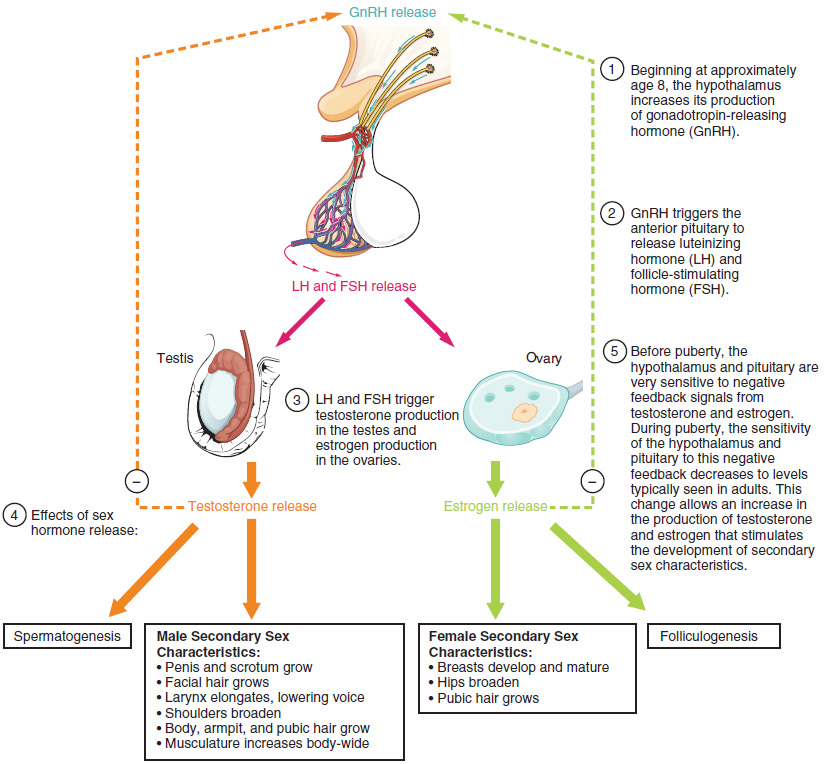81 Males vs. females
Learning Objectives
After reading this section you should be able to-
- Compare and contrast the timing and number of oocytes produced in oogenesis and sperm produced in spermatogenesis.
- Compare and contrast endocrine regulation of spermatogenesis and oogenesis.
- Define puberty.
- Compare and contrast the events of female and male puberty.
- Compare and contrast secondary sex characteristic development in males and females.
Puberty is the stage of development at which individuals become sexually mature. As shown in Figure X.1, a concerted release of hormones from the hypothalamus (GnRH), the anterior pituitary (LH and FSH), and the gonads (either testosterone or estrogen) is responsible for the maturation of the reproductive systems and the development of secondary sex characteristics, which are physical changes in the body.
The first changes begin around the age of eight or nine when the production of LH becomes detectable. The release of LH occurs primarily at night during sleep and precedes the physical changes of puberty by several years. In pre-pubescent children, the sensitivity of the negative feedback system in the hypothalamus and pituitary is very high. This means that very low concentrations of androgens or estrogens will negatively feed back onto the hypothalamus and pituitary, keeping the production of GnRH, LH, and FSH low.
As an individual approaches puberty, two changes in sensitivity occur. The first is a decrease of sensitivity in the hypothalamus and pituitary to negative feedback, meaning that it takes increasingly larger concentrations of sex steroid hormones to stop the production of LH and FSH. The second change in sensitivity is an increase in sensitivity of the gonads to the FSH and LH signals, meaning the gonads of adults are more responsive to gonadotropins than are the gonads of children. Because of these two changes, the levels of LH and FSH slowly increase and lead to the enlargement and maturation of the gonads, which in turn leads to secretion of higher levels of sex hormones and the initiation of spermatogenesis and folliculogenesis.
In addition to age, multiple factors can affect the age of onset of puberty, including genetics, environment, and psychological stress. One of the more important influences may be nutrition; historical data demonstrate the effect of better and more consistent nutrition on the age of menarche in the United States, which decreased from an average age of approximately 17 years of age in 1860 to the current age of approximately 12.75 years in 1960, as it remains today. Some studies indicate a link between puberty onset and the amount of stored fat in an individual. This effect has been documented in both sexes. Body fat, corresponding with secretion of the hormone leptin by adipose cells, appears to have a strong role in determining menarche. This may reflect to some extent the high metabolic costs of gestation and lactation. In individuals who are lean and highly active, such as gymnasts, there is often a delay in the onset of puberty.

Signs of Puberty
Different sex steroid hormone concentrations also contribute to the development and function of secondary sexual characteristics. Examples of secondary sexual characteristics due to a predominance of testosterone or estrogen are listed in Table X.1.
An increased production of estrogen at puberty typically leads to the development of breast tissue. This is followed by the growth of axillary and pubic hair. A growth spurt typically starts at approximately age 9 to 11, and may last two years or more. During this time, an individual’s height can increase an average of 3 inches a year. The next step in puberty due to estrogen is menarche, the start of menstruation.
An increased production of testosterone leads to growth of the testes, typically the first physical sign of the beginning of puberty, which is followed by growth and pigmentation of the scrotum and growth of the penis. The next step is the growth of hair, including armpit, pubic, chest, and facial hair. Testosterone stimulates the growth of the larynx and thickening and lengthening of the vocal folds, which causes the voice to drop in pitch. The first fertile ejaculations typically appear at approximately 15 years of age, but this age can vary widely across individuals. The prostate normally doubles in size during puberty. A growth spurt occurs toward the end of puberty, at approximately age 11 to 13, and height can increase as much as 4 inches a year. In some individuals, pubertal development can continue through the early 20s.
Environmental and Genetic Factors Influencing Puberty Onset
In addition to age-related factors, the onset of puberty is influenced by a combination of genetic and environmental factors. Genetic predisposition plays a significant role in determining the timing of puberty, with variations in specific genes affecting the release and sensitivity to puberty-related hormones.
Environmental factors, such as nutrition and overall health, also contribute to the timing of puberty. Adequate nutrition, especially in terms of sufficient body fat, is associated with an earlier onset of puberty. Studies have shown that individuals with a higher body mass index (BMI) may experience puberty at an earlier age than those with lower BMIs.
Furthermore, exposure to certain environmental factors, such as endocrine-disrupting chemicals and stress, can impact the delicate balance of hormonal regulation during puberty. Psychological stress, in particular, has been linked to alterations in the timing of puberty onset.
Adapted from Anatomy & Physiology by Lindsay M. Biga et al, shared under a Creative Commons Attribution-ShareAlike 4.0 International License, chapter 27.

